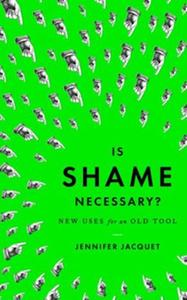 Spend five minutes in the comments section of any major publication's website, and you'll be excused for thinking that the feeling of shame is endangered and on the borderline of extinct. The idea that shame still exists as a public construct and in fact could prove indispensable is the seed of Jennifer Jacquet's remarkable book, Is Shame Necessary? (see our review below).
Spend five minutes in the comments section of any major publication's website, and you'll be excused for thinking that the feeling of shame is endangered and on the borderline of extinct. The idea that shame still exists as a public construct and in fact could prove indispensable is the seed of Jennifer Jacquet's remarkable book, Is Shame Necessary? (see our review below).
Jacquet is an assistant professor in the Department of Environmental Studies at New York University, where she's an environmental social scientist interested in large-scale cooperation dilemmas, particularly in overfishing and climate change.
Let's start with the distinction between guilt and shame, the private versus public aspects of the two, and where they overlap.
A lot has been written on the emotional differences between guilt and shame, but less exists on the distinction in terms of punishment, which is my focus in the book. I chose to distinguish shame from guilt as a punishment that requires an audience--real or imagined. In contrast, guilt is a form of self-punishment--something that occurs between an individual and that individual's conscience.
You write about the limits of shaming, citing as an example criminals forced by judges to wear shirts announcing their crimes to the public, and how many people would feel this is too dehumanizing a punishment. However, there's a growing sentiment in this country that the justice system is failing everyone except the wealthy. How can shame be applied in a way that makes change, but also doesn't cross a line into a metaphorical public flogging?
As you point out, formal punishment seems to be missing for certain transgressions, especially transgressions by some of the most powerful actors in society. This is where shaming can play a role. It's a form of punishment that is still available to the general public (unlike prison, for instance, which is a tool that can only, for very good reasons, be used by the state).

Also keep in mind that many of those public floggings weren't seen as problematic in their day. Shaming and the forms it takes are calibrated to the standards of the time. However, because shaming requires attention, and attention is a limited resource, we must always treat shaming with care. In the book, I compare shaming with antibiotics, which can be used effectively but can also be overused and then backfire.
It seems there is an increasing number of protest marches and rallies, including the marches on Washington and thousands of people in the streets of New York following the Eric Garner verdict. Are they effecting change?
Sure. The marches signal to society what issues are important. Shaming is nothing without a standard of behavior with which to compare the shameful behavior. The more visible and widely understood the norms of behavior are, the more easily shame can be applied. For raising the profile of an issue, it's certainly more effective to turn out for a march than to click "like" on Facebook.
Yet the "standard of behavior" seems to be up for grabs. In the case of Eric Garner, while many people were outraged, some tried to make a case that hair-trigger judgments need to be made by police officers and a "rush to judge" their actions can undermine their work. When the media covers both viewpoints, there's no clear behavioral norm being held as the standard.
Yes, that's right. The standard of behavior is always up for grabs and there can be long struggles between what standard should win. We should not take any norms in our society for granted or assume that things always will remain the same. In the book, I mention cultures that have rituals to severely mutilate genitals, or flatten babies' heads, or bind women's feet. These are practices that, despite being biologically maladaptive, have managed to persist (not that they always will), and they provide evidence that behavior and standards and norms are, just as you say, always up for grabs. I think the fact we're talking about Eric Garner shows the power of both the media and the marches, in addition to the obvious atrocity.
What are the implications of using shame as a tool in education?
This really depends on the context. In general, I would avoid using shame in the classroom, as I don't think it encourages a lot of the values we want in kids. One of the many conclusions I've drawn through this research is that shaming is much more useful for encouraging pro-social behavior than for encouraging individual learning or innovation. But if we instead look at what people like celebrity chef Jamie Oliver have done in shaming schools and food providers to get children more nutritious lunches, then you see the potential power of using shame to change behaviors for the better at a large scale. --Matthew Tiffany, LCPC, writer for Condalmo and psychotherapist

